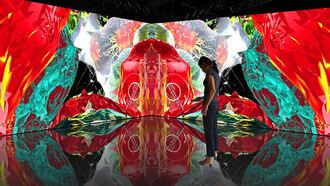Everything we once knew as "true" has been deconstructed—our values, our perception of reality, and even our definition of art. The past decade has been a whirlwind of social, political, and technological disruptions, each fracturing the world into an increasingly surreal landscape. We live in an era where certainty has collapsed, and the modern art that emerges from this world reflects that collapse.
Politics has become performance art. Technology has become mythology. The individual, once the center of meaning, now floats in a sea of algorithmic illusions. The very concept of truth—moral, artistic, and philosophical—has been flipped upside down. In this upside-down world, art no longer seeks beauty or meaning. Instead, it revels in confusion, irony, and fragmentation.
The collapse of meaning: post-Trump cultural disorientation
The Trump era is not just a political anomaly—it is a seismic event that shook the foundations of how people perceive truth and authority. Trump’s communication style—an unpredictable mix of arrogance, misinformation, and theatrical chaos—became a form of performance art. Post-truth politics, the distortion of reality, and the cult of personality took center stage.
Art responded accordingly. The traditional grand narratives collapsed. Surrealism made a comeback—not as a conscious artistic movement, but as an everyday experience. Satirical absurdity became the default tone of cultural expression. Consider the rise of glitch art, AI-generated nonsense, and conceptual pieces that exist solely to mock their own existence. It wasn’t just about questioning authority—it was about questioning whether anything could be taken seriously at all.
Memes became the new Dadaism. Once dismissed as lowbrow internet humor, they evolved into an art form of pure nihilism—images and phrases detached from meaning, endlessly circulating in the void of the digital world. Irony became the only way to process reality.
Elon Musk and the techno-God paradox
If Trump is the embodiment of chaotic destruction, Musk is the manifestation of technological absurdity. Elon Musk does not simply innovate—he mythologizes himself, shaping reality through spectacle. He tweets a Dogecoin meme, and the stock market fluctuates. He makes a passing comment about AI and the entire conversation on human consciousness shifts.
Musk represents a paradox: he is both the utopian visionary and the trickster god. He preaches about colonizing Mars while engaging in juvenile online battles. He launches electric cars into space while mocking the very people who idolize him. This duality—messiah and jester—mirrors modern art’s fascination with contradiction.
The art world has responded with a growing obsession with technology, AI, and transhumanism. The aesthetic of our time is no longer handcrafted—it is generated, coded, and manipulated by machines. AI-generated artworks, interactive installations, and digital simulations are replacing traditional mediums. The old concept of the "artist-genius" is dissolving. Who is the creator when a neural network produces artwork? Does authorship even matter anymore?
How modern art became the mirror of a fragmented reality
Once upon a time, art was about grand ideas—religion, love, revolution. Today, it reflects the fragmentation of reality itself. We live in a post-narrative world where stories don’t have clear beginnings or endings. This is why modern art often appears as a chaotic mess—glitch aesthetics, distorted imagery, and decentralized meaning.
Look at the rise of digital surrealism: pixelated, looping animations that exist in the ether of cyberspace, NFT art that has no physical presence but sells for millions, and AI-created artworks that no human ever actually touched. Art is no longer a reflection of reality; it is an extension of our digital hallucinations.
Irony is the new sincerity. The postmodern rejection of meaning has evolved into a hyper-modern rejection of authenticity. Even sincere art often carries a layer of self-awareness, as if winking at the viewer: Do you think this means something? Maybe it does. Maybe it doesn’t.
The return to the self: searching for meaning in the void
Yet, amidst all this chaos, a counter-movement is emerging—one that seeks to return to something real. As everything becomes digitized, mechanized, and ironic, a growing number of artists are rejecting nihilism and searching for deeper meaning.
Neo-spiritualism is rising in the art world. Psychedelic art, inspired by ancient mysticism and cosmic consciousness, is making a comeback. Artists are turning to meditation, altered states, and Eastern philosophies to create works that transcend the digital noise. There is a yearning for the organic, the raw, the human.
This paradox defines our era: as we accelerate toward a hyper-digital future, we also long for something deeply personal, significant. In a world where AI can create, curate, and sell art, the role of the human artist is shifting—not as a creator of objects but as a seeker of truth.
Art in the age of the unknown
The world has turned upside down, and art has followed suit. Nothing is certain anymore—not truth, not values, not even the role of the artist. But perhaps this collapse is not an end but a transformation.
Art has always been a reflection of its time, and our time is defined by paradox, absurdity, and disorientation. Yet, in this very disorder, we may be witnessing the birth of something new—an era where art is not just about beauty or meaning but about navigating the unknown.
The question remains: Is art leading us toward a new awakening, or are we just witnessing the final collapse of meaning itself?















